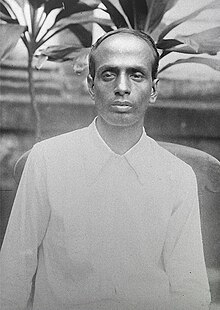Surya Sen
Surya Sen (* 1894 in the village of Noapara, British India , † January 12, 1934 in Chittagong ) was a Bengali revolutionary who organized the failed Chittagong uprising in 1930 and was therefore executed .
Life path
Surya Sen received his teacher training at Beharampore College ( Murshidabad District ). In the late 1920s he taught mathematics at the Uma Tara School in Chittagong. Because of his teaching activities, he was also known as a Master-da .
As early as 1918 he was a founding member of the revolutionary organization ( Samyasram ) of Chittagong and a member of its central committee. The group was inspired by the methods of Giuseppe Mazzini and the Carbonari . At first Gandhi's campaign of non-cooperation was supported , but then violent action was turned.
To finance revolutionary activities, Surya Sen planned robberies. On December 24, 1923, he swallowed a cyanide capsule when he with others in his hideout in the village of Sulak Bazar was surrounded by police. He was only passed out and saved in the hospital. In the following court case because of the robbery on the 14th of a railroad carriage, in which 17,000 rupees were looted, he was acquitted by the jury, although he had been involved.
On September 5, 1924, he took part in a robbery in Noapara . In another attack on November 25, 1925, they managed to escape. Several of his campaigners were charged in the Dakshineshwar Bomb Case .
Because of his nationalist activities, he was imprisoned from October 8, 1926 to 1928 without trial under the provisions of the notorious Regulation III of 1818. After that, he and his group continued to be active within Congress . He and five of his comrades were members of the party's Chittagong District Committee . During the annual meeting of the Indian National Congress in Calcutta from December 29th to 31st, 1928, his comrades helped organize marches. After Jatin Das died in British custody after a 64-day hunger strike in September 1929, he radicalized himself further and co-founded the Advance Group , which he later named Indian Republican Army (IRA, based on the Irish model ).
Chittagong uprising
After six months of preparation, Surya Sen led the Chittagong uprising, which was hopeless from the outset, on April 18, 1930 . In order to distract his police guards from his immediate plans, Sen had announced that he would publicly read from a forbidden book on the 21st, which would have complied with the criminal offense of sedition.
In front of the barracks of the armed police (Police Armory) in the north-western district of Pahartali , Surya Sen first raised the Indian tricolor as the national flag and had it saluted, then he proclaimed a “provisional revolutionary national government”. Then the barracks were stormed with ten men. He left the city with other revolutionaries. Posed by the British pursuers on Jalallabad Hill, action broke out on April 23. The freedom fighters infiltrated one by one into the surrounding villages, where they obtained civilian clothes.
Between September 1930 and June 3, 1931, Surya Sen attempted to free his imprisoned militants through attacks in Chittagong. Those involved were tried in the so-called Dynamite Conspiracy Case . On June 13, he managed to escape the police in the Dhalgat district of Chittagong. Captain Cameron was shot dead.
Surya Sen was betrayed in Gairala on February 16, 1933 and captured along with Brajen Sen. Brajen's older brother, the informer Netra Sen, was beheaded from behind by Kiran Sen on January 9, 1934 at dinner, for which he was never held responsible.
From June 15, 1933, Surya Sen was tried with others in a special court - 170 witnesses were heard - and sentenced to death . On January 12, 1934, he was brutally mistreated by the colonial rulers and hanged shortly after midnight in the central prison of Chittagong . Chittagong was under a curfew with a shooting order that day . He was found guilty not only of the rebellion and the gun and explosives offenses, but also of the murder of Captain Cameron in Dhalgat on June 13, 1932 and Ms. Sullivan on September 24, 1932 in Pahartali.
His body was dumped in the Bay of Bengal from the battle cruiser HMS Renown .
literature
- Ardhendu Guha (Ed.): Chittagong Uprising Golden Jubilee Souvenir. Calcutta 1980.
- Intelligence Bureau, Home Dept., Government of India: Terrorism in India, 1917–36. Shimla 1937.
- David Laushey: Bengal Terrorism and the Bengal Left, 1905–42. Calcutta 1975.
- Mallikarjuna I. Sharma: Easter Rebellion in India. The Chittagong Uprising. Hyderabad 1993.
Individual evidence
- ↑ a b Mallikarjuna I. Sharma: Easter Rebellion in India. Appendix 35.
- ↑ Bipan Chandra: India's Struggle for Independence. New Delhi 1989, ISBN 0-14-010781-9 , pp. 250-258.
- ↑ Mallikarjuna I. Sharma: Easter Rebellion in India. Appendix 9.
- ^ Judgment of September 29, 1931 reprinted in: Mallikarjuna I. Sharma: Easter Rebellion in India. Appendix 32.
- ^ Course of events: Mallikarjuna I. Sharma: Easter Rebellion in India. P. 300.
- ↑ Mallikarjuna I. Sharma: Easter Rebellion in India. P. 306 ff. (Confirmed judgment of November 14, 1933 printed in Appendix 31).
| personal data | |
|---|---|
| SURNAME | Sen, Surya |
| ALTERNATIVE NAMES | Masterda (honorary name) |
| BRIEF DESCRIPTION | Bengali revolutionary in the Chittagong uprising |
| DATE OF BIRTH | 1894 |
| PLACE OF BIRTH | Noapara (Bengal) |
| DATE OF DEATH | January 12, 1934 |
| Place of death | Chittagong |
